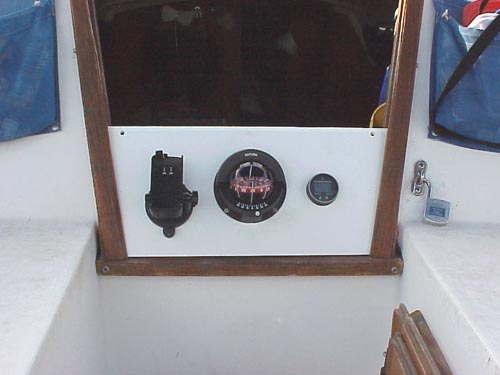
|
|
|
|
|
|
|
|
|
|
|
|
|
|
|
|
|
|
|
|
|
|
|
|
|
|
|
|
|
|
|
|
|
|
|
|
|
|
|
|
|
|
|
|
|
|
|
|

 Sunrise - Thermoelectric Cooler, Stove, Instruments, and Trash Modifications
Sunrise - Thermoelectric Cooler, Stove, Instruments, and Trash Modifications This tip submitted by Christopher A. Chung

Thermoelectric Cooler
There has been a lot of discussion as to the merits of thermoelectric cooling on boats. Because of the high expense of regular marine cooler systems, I decided to limit myself to a thermoelectric cooler. If it didn't work out in the boat, I could always use it elsewhere. The model I selected was the Igloo Kool Cruiser. This model costs about $80 and consumes around 4-5 amp hours. This unit is particularly flexible since the complete cooling unit is in the lid of the cooler. In the beginning I just left the cooler on the cabin floor. I eventually accidentally discovered that with a little bit of effort that the complete unit will also fit into the existing ice box.
While this was a perfectly usable solution, it reduced the usable space and I decided that I was interested in a more finished appearance. I cut a piece of starboard the size of the original icebox cover with a hole in it for the top cooling unit. I used a table saw to form a lip on the starboard so that it fits snuggly. A router would probably be easier to use. You can also weather strip and insulate the starboard to improve cooling performance.
The starboard base fits in the opening of the icebox and the cooling unit fits in the starboard base. Since the unit is 12 volt, I also purchased the 120 volt converter for about $40. At the dock, the unit runs 24 hours a day off of AC. After all, you never know when you might want a cool drink. I image that you probably run the unit off of your boat's 12 volt system for day sails without too deep a discharge.
By using the original icebox, there is now a great increase in the available volume over the Kool Cruiser. My icebox also has much thicker insulation than the Igloo. In addition, the new system can still use ice. The water can still be drained. Before the modification, it was rather inconvenient to keep removing the cooler from the icebox to remove the water.
The new system is still subject to thermoelectric limitations. However, in actual practice, I have found that no matter how hot it is in Houston, the drinks are always cooler than I am. Despite the limitations, I consider this to be one of my best dollar for dollar purchases on the boat.

Stove.
Since I never used both burners and I was always short on counter space, I split the stove cover into two pieces. A piano hinge supports the back of the covers. On the right side, I have a Nissan stainless steel pump thermos. This thermos also has a stainless liner inside, so you don't have to worry about breaking the glass. The stove was converted to propane using the instructions that were posted on the site. I originally had the disposable tank hooked up to the stove inside the cabin. I stored the cylinders outside in the shallow locker. With the small release of gas whenever the cylinder was removed, I became worried about the build up of propane in the bilge. After posing this issue in the forum, I decided to purchase some additional high pressure hose. The new hose now leads under the stove to the port locker and out into the cockpit.

Instruments.
I mounted my gps, compass, and depth finder on a piece of starboard the size of the lower hatchboard. When I am not sailing, the instrument panel hangs on hooks behind the starboard settee. I have seen a lot of instruments mounted to the bulkhead without covers that have been cracked, clouded, or faded. Since the instruments inside the cabin are out of direct UV light, the compass and LCD displays should have a longer service life.

Trash Can.
Trash aboard Sunrise has always been difficult to handle. The closest that I have come to a solution is one of those half round plastic cans that mounts to the drawer below the stove. The picture shown is the trash can off of the boat. Notice yet another piece of starboard put to good use. This piece is attached to the trash can with a piano hinge. I put this on mostly so that I wouldn't have to see the trash inside.
Final Comments.
Most of the modifications described in this tech tip used starboard. A 24 by 27 by 1/2 inch sheet of this material costs an outrageous $45. It was a long time before I could bring myself to pay this kind of money for a piece of plastic. However, I was able to use the starboard in a lot of projects that I had been meaning to undertake. Overall, I think I got my moneys worth out of the sheet of starboard. I know that it got more than its money worth out of me.